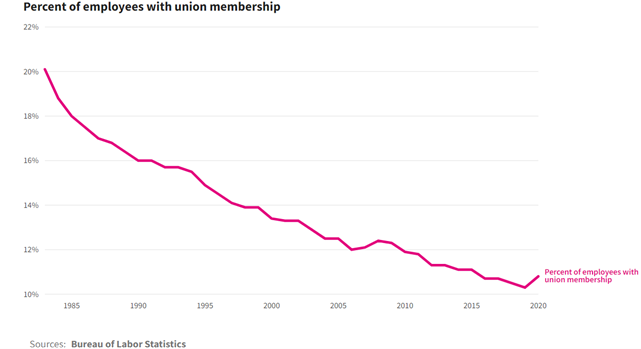Temp Workers May Finally See Improvements in the Law
December 16, 2021Unemployment Appeal May Not Be Denied Unreasonably
December 30, 2021By: Ashley A. Smith, Esq. and Ty Hyderally, Esq.
When just one of more than 15,000 Starbucks locations in the U.S. makes national news, it’s got to be quite a story.
Just this month, workers at a Starbucks store in Buffalo, New York voted to become the first corporate-owned Starbucks store in the U.S. to officially unionize. News cameras captured employees’ celebrations.
Those workers sure look delighted. It sounds like good news.
But if you’re like many Americans, you may be wondering…

In 2020, only 10.8% of American workers were union members. It’s likely that you, the person reading this blog right now, are not and have never been a union member. It’s quite possible that you don’t know anyone else who is.
But decades ago, that was a lot less likely.

A labor union, a.k.a. trade union, is an organized group of workers who have come together to achieve common goals, such as improving wages, benefits, and other working conditions.
Union activity is as American as apple pie. While historians identify different organizations as the “first union” in the U.S., they agree that labor unions have existed in the U.S. for at least 151 years. Indeed, labor strikes on American soil date back to colonial times.
Under English common law, workers participating in a “conspiracy to raise wages” was illegal. The legality of “labor combinations” in the U.S. was uncertain until a group of mid-19th century court decisions addressed the issue squarely. In Commonwealth v. Hunt and others, courts ruled that labor combinations were legal, so long as they were organized for a legal purpose and using legal means to achieve their objectives.
And then they all lived happily ever after, right?

Enter the Great Upheaval, and a slew of events which began with workers peaceably asserting their rights to fair pay, sensible work hours, and safe working conditions, and ended in violence.
Then, workers faced attacks on another front. In 1908, the U.S. Supreme Court upheld “yellow-dog” contracts – contracts forbidding employees from joining labor unions – as constitutional.

This decision came as a shocker to many and was opposed by President Roosevelt. In fact, some say it was because the justices bowed to political pressure, after President Roosevelt threatened to “pack” the Supreme Court with new appointees, that the Court reconsidered it’s decision. In 1937, the Court decided to overturn the decision allowing for “yellow dog” contracts.
In the meantime, highly contentious strikes continued. This led to the enactment of various labor acts, including the National Labor Relations Act of 1935 (the “NLRA”), which aims to correct the “inequality of bargaining power” between employers and employees by promoting collective bargaining.
Following a major strike wave in the mid-1940s, the NLRA was amended by the Taft-Hartley Act, which imposed limits on the rights that the NLRA conferred to workers and unions.
Surely the pendulum has swung back since 1947?

To date, subsequent attempts to amend the NLRA have failed. Thus, a 74-year-old law continues to set the parameters for labor organizing and action in the U.S.
That sounds pretty bleak. Why do Starbucks workers care about a union, anyway?
As a union, workers at the union Starbucks store in Buffalo have won the ability to collectively negotiate a contract for better wages, benefits, and working conditions.
More broadly, while this success seems small, labor scholars predict that it may be the droplet that starts a deluge.

In fact, it’s already spread to other Starbucks stores.
According to a recent Gallup poll, 68% of Americans approve of unions – the highest rate since 1965. It just may be the right time for unions to make a comeback.

Just kidding. Here in New Jersey, they never left.
(Photo from https://skylark-diner-lounge.business.site/)
The history of workers’ rights in the U.S. continues to be written every day. We have high hopes for the next chapter.
Note: This blog post intends to provide a cursory overview, not a full and comprehensive history, of union activity in the U.S. The contributions of people of all races, genders, creeds, and national origins to the American labor movement can hardly be overstated.
For further reading:
- Labor Movement, HISTORY
- Labor Wars in the U.S., PBS
- Our Labor History Timeline, AFL-CIO
- Civil Rights and the Labor Movement, Teamster.org
En nuestra firma hablamos español. This blog is for informational purposes only. It does not constitute legal advice, and may not reasonably be relied upon as such. If you face a legal issue, you should consult a qualified attorney for independent legal advice with regard to your particular set of facts. This blog may constitute attorney advertising. This blog is not intended to communicate with anyone in a state or other jurisdiction where such a blog may fail to comply with all laws and ethical rules of that state of jurisdiction.

